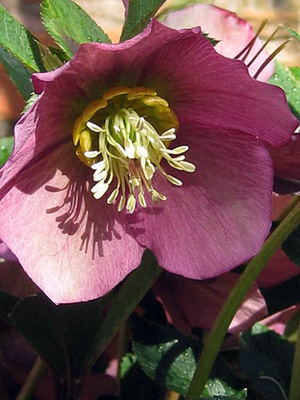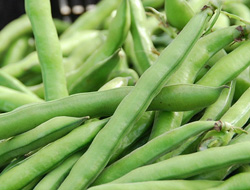 Cashier: Picking up the two fennel bulbs I was buying and examining them. "Do you cook with fennel a lot?"
Cashier: Picking up the two fennel bulbs I was buying and examining them. "Do you cook with fennel a lot?"
Me: "Oh, yeah. All the time."
Cashier: "I’ve always wondered what to do with it. It just looks so cool, you know?"
Me: "Oh, I can give you lots of idea about how to cook with fennel. You could put it in salads or saute --"
Cashier: Waving the hands as if she were trying to stop traffic, she interrupted, "Oh, no, no! I don't want you to tell me. I won’t actually do it. I’ve just always wondered."
In case you're wondering about fennel bulb, it's actually an herb that has been enjoyed since antiquity. When eaten raw, you'll appreciate its crunchy, refreshing celery-like texture and sweet licorice flavor. When sauteed or roasted, you'll find it morphs into something more savory, with an earthy depth of flavor. It gets along well with many ingredients but has a special affinity for citrus fruits, figs, olives, nuts, and hard cheese like Pecorino Romano and Parmesan. And those feathery fronds? They're edible too. Toss them in your salad or munch on them as a digestive aid.
Spring
Spring
Lenten Roses
 During the season of Lent, an herbaceous perennial sends up its hearty bells of florets on sturdy stems – bridging the gap between winter and spring.
During the season of Lent, an herbaceous perennial sends up its hearty bells of florets on sturdy stems – bridging the gap between winter and spring.
As with the season of Lent itself – a wintry season of contemplation, spiritual focus, and petition - these symbols of new life out of the deathlike state of winter are emblems of the newness of spring, rebirth, and rejuvenation.
Helleborus is the genus name for Lenten Roses to which these perennials are often referred as Hellebores. Hellebores range from garnet to ruby, lilac to lavender, and to the purest white. Once the flowers begin to fade, the petals become chartreuse and lime green, lasting for months on their stems and for days in arrangements. Some of the flowers are the simplest, five petal blossoms you’ll ever see, while others are compound arrays of florets with freckles or dark nectaries complemented by bright sepals.
Leathery leaves, pretty and green, make for a delightful texture in the garden. The dark green of the Christmas Rose, Helleborus niger, is quite stunning around Christmas time and into January. The pure white flowers dangling above the glossy greenery are beautiful sentiments for the Christmas Holidays. From there, cultivars and cross species of Helleborus orientalis will begin to emerge and bloom through the winter and especially during Lent…quite an appropriate name, eh? From bloom time to color to texture, I’m sure you’ll be able to find a Hellebore to suit your garden’s fancy.
Foxgloves and Delphiniums
 Elegant…purely elegant is the word that comes to mind when I think of foxgloves and delphiniums. Very similar in appearance and growth habit, these two garden goodies are excellent additions the spring tableau and fantastic in arrangements.
Elegant…purely elegant is the word that comes to mind when I think of foxgloves and delphiniums. Very similar in appearance and growth habit, these two garden goodies are excellent additions the spring tableau and fantastic in arrangements.
Digitalis purpurea is the Latin name for foxgloves. The genus Digitalis gathers its name from the ease of which one’s fingers, or digits, can be capped by the floral bells cascading down their stalks. In literary lore, a fox could slip its paws into the bells and use them as gloves - thus the common name. I bet Beatrix Potter had something to do with that. Pinks, creams, lavenders, lilacs, yellows, peaches, and speckled mixes of them all abound in the foxglove color range.
As for other uses besides gorgeous garden elements, the Digitalis genus is used in cardiology to create several types of heart medicine and even some neurological medicines. Quite amazing considering the whole plant, roots, leaves, seeds, and stems are toxic! The pharmaceutical positives are extracted from the leaves…somewhat akin to using snake venom for medicine or a flu vaccination. Don’t worry about the toxicity…just don’t eat them!
Sautéed Mixed Greens
 Bags of organic arugula at the store always tempt me. "Buy me!" they say, "Eat salad for a week, it'll be great!" Of course after three or four days the bag is half full and the contents start to look rather wilted and sad. Then comes regret. Why did I buy that bag in the first place? Recently I found the solution to the problem of wilting greens, a problem that I'm guessing may also be yours.
Bags of organic arugula at the store always tempt me. "Buy me!" they say, "Eat salad for a week, it'll be great!" Of course after three or four days the bag is half full and the contents start to look rather wilted and sad. Then comes regret. Why did I buy that bag in the first place? Recently I found the solution to the problem of wilting greens, a problem that I'm guessing may also be yours.
It turns out arugula is quite wonderful when lightly sauteed in olive oil. It's somewhat bitter and earthy but in a good way. It's even better if you mix it with some other greens. I use a bit of frozen spinach which is mild but silky and some fresh escarole which has a lovely spring flavor and juiciness when it's cooked. The mixture of flavors and textures creates a compelling dish that isn't just a terrific side dish, but begs to be layered in a grilled cheese sandwich. With or without ham or bacon, this is good stuff!
A Fava Bean by Any Other Name Would Taste as Good
 Finally, the wait is over! Fava beans are in season. They appeared for the first time last Sunday, and I couldn't be happier. I know how hard the wait has been on you too, but you can rest easy now. Well don't rest too easily. Fava beans have a depressingly short season--usually just 4-5 weeks in April-May.
Finally, the wait is over! Fava beans are in season. They appeared for the first time last Sunday, and I couldn't be happier. I know how hard the wait has been on you too, but you can rest easy now. Well don't rest too easily. Fava beans have a depressingly short season--usually just 4-5 weeks in April-May.
Fava (FAH vah) beans, like artichokes, asparagus, and English peas are a hallmark of spring time produce. These meaty, chewy legumes are exceptionally flavorful; they're similar in taste to edamame and have the firm texture of lima/butter beans. In general, the larger the pod, the better the bean. So when you see them, buy them, even if they're $3.00-4.00/pound. You won't be disappointed.
And don't worry about what to call them. According to Wiki and Cook's Thesaurus, you're correct if you say Vicia faba, broad bean, butter bean, faba bean, English bean, field bean, horse bean, tic bean, or Winsdor bean. I'm not making this up. I think someone actually wrote a dissertation entitled "The Many Appellations of the Bean, Fava."
So call 'em whatever you want, just don't miss them. And follow these instructions for shelling. They take a little effort because you have to shell them twice, but trust me, they're worth it.
More Articles ...
Welcome to the new One for the Table ...
Our Home Page will be different each time you arrive.
We're sure you'll find something to pique your interest...


